
The Joker is a supervillain appearing in American comic books published by DC Comics. The character was created by Bill Finger, Bob Kane, and Jerry Robinson, and first appeared in the debut issue of the comic book Batman on April 25, 1940. Credit for the Joker's creation is disputed; Kane and Robinson claimed responsibility for the Joker's design while acknowledging Finger's writing contribution. Although the Joker was planned to be killed off during his initial appearance, he was spared by editorial intervention, allowing the character to endure as the archenemy of the superhero Batman.

The Legion of Doom is a group of supervillains who originated in Challenge of the Superfriends, an animated series from Hanna-Barbera based on DC Comics' Justice League. The Legion of Doom has since been incorporated into the main DC Universe, appearing in comics, as well as further animated and live-action adaptations, and also video games.
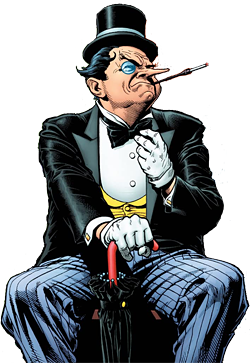
The Penguin is a supervillain appearing in American comic books published by DC Comics, commonly as an adversary of the superhero Batman. The character made his first appearance in Detective Comics #58 and was created by Bob Kane and Bill Finger. The Penguin is one of Batman's most enduring enemies and belongs to the collective of adversaries that make up Batman's rogues gallery.

The Scarecrow is a supervillain appearing in American comic books published by DC Comics. Created by Bill Finger and Bob Kane, the character first appeared in World's Finest Comics #3. He has become one of the most enduring enemies of the superhero Batman and belongs to the collective of adversaries that make up his rogues gallery.
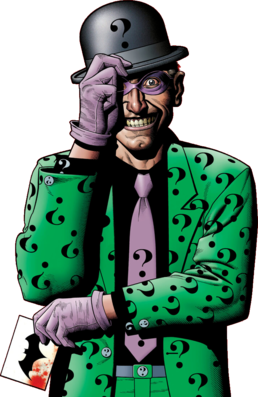
The Riddler is a supervillain appearing in American comic books published by DC Comics. The character was created by Bill Finger and Dick Sprang, and debuted in Detective Comics #140 in October 1948. He has become one of the most enduring enemies of the superhero Batman and belongs to the collective of adversaries that make up his rogues gallery.

The Marvel Family, also known as the Shazam Family, are a group of superheroes who originally appeared in books published by Fawcett Comics and were later acquired by DC Comics. Created in 1942 by writer Otto Binder and artist Marc Swayze, the team was created as an extension of Fawcett's Captain Marvel franchise, and included Marvel's sister Mary Marvel, their friend Captain Marvel Jr., and, at various times, a number of other characters as well.

Bulletman and Bulletgirl are fictional superheros originally published by Fawcett Comics.
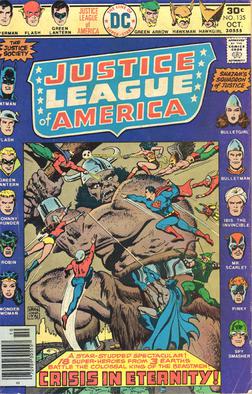
The Squadron of Justice was a name used by two superhero teams of characters who originated from Fawcett Comics. Each team only made one appearance in a single story.

Mister Mind is a fictional supervillain appearing in American comic books published by DC Comics, primarily as an enemy of Captain Marvel. Created by Otto Binder and C. C. Beck for Fawcett Comics, the character made a cameo appearance in Captain Marvel Adventures #22 before making his full first appearance in Captain Marvel Adventures #26. Mister Mind is a two-inch alien caterpillar of high intelligence with telepathic powers who usually carries out his villainous plans through an organization called the Monster Society of Evil. The Society made its debut in Captain Marvel Adventures #22, and the resulting "Monster Society of Evil" story arc continued for two years in Captain Marvel Adventures, ending with issue #46.

The Spellbinder is the name of four fictional supervillains who appear in comic books published by DC Comics. Versions of the character have appeared on the animated series Batman Beyond and The Batman.
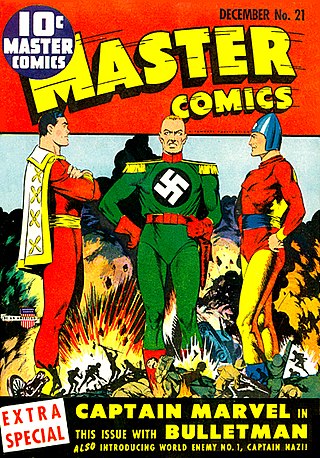
Captain Nazi is a Fawcett Comics and DC Comics supervillain, and rival of Captain Marvel and Captain Marvel Jr.

Firefly is a supervillain appearing in American comic books published by DC Comics. Created by France Herron and Dick Sprang, he made his debut in Detective Comics #184. Initially portrayed as a criminal who utilized lighting effects to commit robberies, Firefly was later reimagined as a sociopathic pyromaniac with an obsessive compulsion to start fires following Crisis on Infinite Earths' reboot of the DC Universe in the 1980s. This darker depiction of the character has since endured as one of the superhero Batman's most recurring enemies and belongs to the collective of adversaries that make up his central rogues gallery.

The Wizard is a supervillain appearing in American comic books published by DC Comics.

Justice is a twelve-issue American comic book limited series published bimonthly by DC Comics from August 2005 through June 2007, written by Alex Ross and Jim Krueger, with art also by Ross and Doug Braithwaite. Its story involves the superhero team known as the Justice League of America confronting the supervillain team the Legion of Doom after every supervillain is motivated by a shared dream that seems to be a vision of the planet's destruction, which they intend to avoid.
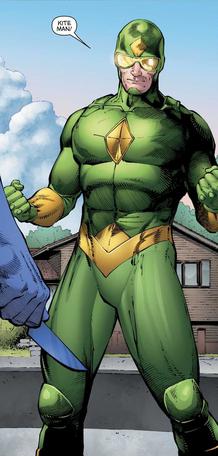
Kite Man is a supervillain appearing in comic books published by DC Comics who uses kite-based weapons to commit crimes. He is commonly depicted as an adversary of Batman. His name is an homage to Peanuts protagonist Charlie Brown, due to the latter character commonly being shown flying kites into trees. The character has been generally regarded as a joke in comparison with other supervillains, due to his dimwitted personality and laughable gimmick. However, with his appearance in the DC Rebirth arc "The War of Jokes and Riddles", Kite Man gained a reputation as a cult favorite character among fans, due to his tragic backstory, persistence and motivation to become a better villain, and his catchphrase "Kite Man, hell yeah!"

Duela Dent is a fictional character in the DC Universe. She is a former member of the Suicide Squad, the Teen Titans and its counterpart, Titans East. Introduced under the alias of the Joker's Daughter, she has also used aliases: Catgirl the Catwoman's Daughter, Scarecrone the Scarecrow's Daughter, the Riddler's Daughter, the Penguin's Daughter, the Card Queen, and the Harlequin. She first appeared in Batman Family #6.

King Kull is a fictional character appearing in American comic books published originally by Fawcett Comics and currently by DC Comics. Created by Otto Binder and C. C. Beck, he originally first appeared in Fawcett Comics’ Captain Marvel Adventures in October 1951, and appeared from then until 1953 when the company ceased publishing its superhero titles. DC later acquired Fawcett's properties, and revived the character in the 1970s.

The Joker is a comic book series published by DC Comics starring the supervillain the Joker. It ran for nine issues from May–June 1975 to September–October 1976, with a tenth previously unpublished issue released in October 2019.



















